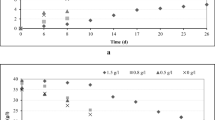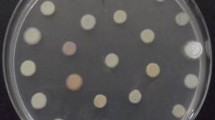Abstract
Of 105 isolates screened for growth on plates containing olive mill wastewater (OMW), five were selected and identified as Pichia fermentans (Y1, Y4) and Candida sp. (Y2, Y11, and Y18). On the basis of their ability to use phenol at 716 mg l−1, strains Y2 (15% reduction) and Y4 (18% reduction) were then used to detoxify stored OMW under various operational conditions. Yeast treatment of OMW increased the pH and, in the best conditions (aeration and no glucose addition), the COD decreased (47%) and phytotoxicity was also decreased (56%) probably due to the changes in the composition of phenolic compounds.


Similar content being viewed by others
References
Amaral C, Lucas MS, Coutinho J, Crespí AL, Anjos MR, Pais C (2008) Microbiological and physicochemical characterization of olive mill wastewaters from a continuous olive mill in northeastern Portugal. Bioresour Technol 99:215–223
Assas N, Ayed L, Marouani L, Hamdi M (2002) Decolorization of fresh and stored-black olive mill wastewaters by Geotrichum candidum. Proc Biochem 38:361–365
Ben Sassi A, Boularbah A, Jaouad A, Walker G, Boussaid A (2006) A comparison of olive mill wastewater (OMW) from three different processes in Marocco. Proc Biochem 41:74–78
Ben Sassi A, Ouazzani N, Walker GM, Ibnsouda S, El Mzibri M, Boussaid A (2008) Detoxification of olive mill wastewater by Maroccan yeast isolates. Biodegradation 19:337–346
Casa R, D’Annibale A, Pieruccetti F, Stazi SR, Giovannozzi Sermanni G, Lo Cascio B (2003) Reduction of the phenolic components in olive-mill wastewater by an enzymatic treatment and its impact on durum wheat (Triticum durum Desf.) germinability. Chemosphere 50:959–966
Cereti CF, Rossini F, Federici F, Quarantino D, Vassilev N, Fenice M (2004) Reuse of microbially treated olive mill wastewater as fertiliser for wheat (Triticum durum Desf.). Bioresour Technol 91:135–140
Esteve-Zarzoso B, Belloch C, Uruburu F, Querol A (1999) Identification of yeasts by RFLP analysis of the 5.8S rRNA gene and the two ribosomal internal transcribed spacers. Int J Syst Bacteriol 49:329–337
Fakharedine N, El Hajjouji H, Ait Baddi G, Revel JC, Hafidi M (2006) Chemical and spectroscopic analysis of organic matter transformation during aerobic digestion of olive-mill waste-waters. Proc Biochem 41:398–404
Gonçalves C, Lopes M, Ferreira P, Belo I (2009) Biological treatment of olive mill wastewater by non-conventional yeasts. Bioresour Technol 100:3759–3763
Jaouani A, Sayadi S, Vanthournhout M, Penninckx MJ (2003) Potent fungi for decolourisation of olive mill wastewaters. Enzyme Microb Technol 33:802–809
Kurtzman CP, Robnett CJ (1998) Identification and phylogeny of ascomycetous yeasts from analysis of nuclear large subunit (26S) ribosomal DNA partial sequences. Antonie Leeuwenhoek 73:331–371
Lanciotti R, Gianotti A, Baldi D, Angrisani R, Suzzi G, Mastrocola D, Guerzoni ME (2005) Use of Yarrowia lipolytica strains for the treatment of olive mill wastewater. Bioresour Technol 96:317–322
Papanikolaou S, Galiotou-Panayotou M, Fakas S, Komaitis M, Aggelis G (2008) Citric acid production by Yarrowia lipolytica cultivated on olive-mill-wastewater based media. Bioresour Technol 99:2419–2428
Paredes C, Cegarra J, Roig A, Sánchez-Monedero MA, Bernal MP (1999) Characterization of olive-mill wastewater (alpechín) and its sludge for agricultural purposes. Bioresour Technol 67:111–115
Sinigaglia M, Di Benedetto N, Bevilaqua A, Corbo MR, Capece A, Romano P (2010) Yeasts isolated from olive mill wastewaters from southern Italy: technological characterization and potential use for phenol removal. Appl Microbiol Biotechnol 87:2345–2354
Yan J, Jianping W, Hongmei L, Suliang Y, Zongding H (2005) The biodegradation of phenol at high initial concentration by the yeast Candida tropicalis. Biochem Eng J 24:243–247
Zucconi F, Pera A, Forte M, De Bertoldi M (1981) Evaluating toxicity of immature compost. Biocycle 22:54–57
Author information
Authors and Affiliations
Corresponding author
Electronic supplementary material
Below is the link to the electronic supplementary material.
Rights and permissions
About this article
Cite this article
Taccari, M., Ciani, M. Use of Pichia fermentans and Candida sp. strains for the biological treatment of stored olive mill wastewater. Biotechnol Lett 33, 2385–2390 (2011). https://doi.org/10.1007/s10529-011-0708-3
Received:
Accepted:
Published:
Issue Date:
DOI: https://doi.org/10.1007/s10529-011-0708-3




